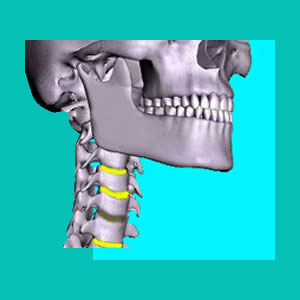
Cervical degenerative disc disease causes can result from normal and expected degenerative processes, traumatic injury and other case-specific or idiopathic factors. The majority of cases of CDDD are due to completely universal spinal aging processes, which are not harmful or inherently painful in any way. It is rare that normal spinal degeneration will produce symptomatic versions of disc desiccation in the neck. Accelerated disc deterioration can also occur from spinal neck injury, such as whiplash, vertebral fracture or intervertebral herniation.
Degenerative disc disease remains the number one scapegoat in the entire back and neck pain sector, since it is found in every patient and is unjustly, but traditionally, blamed for enacting a diversity of symptoms throughout the spine.
This essay delves into the specific causes of disc disease in the cervical spine.
Age-Related Cervical Degenerative Disc Disease Causes
Normal disc degeneration is enacted by getting older and using the spinal structures in typical ways. All the bending and flexing which must be accomplished in the cervical spinal region causes the degenerative effects we commonly see on the intervertebral disc structures.
As the discs age, they tend to dry out and lose structural integrity. This causes the normal signs of CDDD, which include a shrinking in mass, circumference and diameter, as well as the tendency to bulge or herniate in typically asymptomatic ways. The cervical spine features the second fastest rate of intervertebral degeneration in the entire backbone, surpassed only by the lower lumbar zone.
Traumatic Cervical Disc Disease Causes
Spinal injuries, as well as abnormally excessive wear and tear, can accelerate disc degeneration, leading to advanced or extreme cases of CDDD earlier in life. While it is normal for people to have mild to moderate degeneration in the cervical spine by the age 30, circumstances, injury and congenital factors might enact these same levels far younger.
Traumatic injury can make degeneration more pronounced and allow the condition to progress faster. However, there is little, if any, evidence that injury leads to more symptomatic versions of CDDD, contrary to popular medical mythology.
The most common type of injuries that are cited as being contributory to exacerbated degenerative processes include whiplash events that are usually suffered during sports and motor vehicle accidents.
Vertebral fracture is also a relatively typical reason why the cervical spine might suffer accelerated deterioration.
One of the least often considered injurious causes of cervical spinal degeneration is certainly any invasive surgical technique that is performed on the neck, especially spinal fusion.
Structural Cervical Degenerative Disc Disease Causes
Below are listed some of the other possible causes and contributors to the development of cervical disc deterioration:
Instances of enduring atypical spinal curvature can place inordinate wear on the cervical disc spacers.
Exaggerated and deficient cervical lordosis are both implicated as the main types of curvature-related degeneration.
Cervical scoliosis is rare, but can also play a part in select patient profiles.
Finally, some patients simply demonstrate a genetic, congenital or developmental disposition to suffering severe intervertebral deterioration in the neck. Some patients display thinner than usual disc structures or the tendency for these tissues to break down quicker than would otherwise be expected.
Surprising Causes of Cervical Degenerative Disc Disease
The neck is responsible for moving and supporting the head throughout the rigors of an active life. This is a difficult job, as the spinal structures in the cervical region are smaller than anywhere else and the head is a very heavy weight.
Cervical disc degeneration most often results from the normal processes of life and is generally no cause for alarm or concern. If your pain has been implicated as coming exclusively from a CDDD process in the neck, there is a good chance that you have been misdiagnosed.
In this case, you would be wise to investigate alternate explanations for your pain, or else face failed treatment after failed treatment, most likely ending with an unsuccessful surgical nightmare. This is not editorial speculation, but instead is educated guidance, based on statistical evidence.
Remember, there is nothing inherently pathological about disc desiccation. In our experience, the only time CDDD seems truly unusual is when it is absent.
Herniated Disc > Cervical Degenerative Disc Disease > Cervical Degenerative Disc Disease Causes





